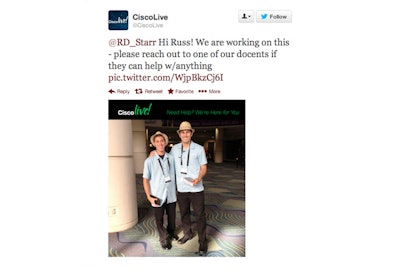
Around 8:30 a.m. on the first full day of Cisco Live at the Orange County Convention Center last month, the first tweets appeared indicating that something was wrong with the event’s mobile app. “Anyone at Cisco Live NOT having problems with the mobile app? #CLUS,” tweeted @brianmiddleton. Then more complaints poured in, and Cisco staffers monitoring Twitter from the event’s social media hub knew they had an issue to address.
“This was a new app for us this year, so we were still getting the bugs out to get it ready for the event. Unfortunately, there was still a bug, and there was frustration immediately noticed by the attendees when they weren’t able to access their schedule and sessions through the app,” said Kathleen Mudge, Cisco’s social media manager.
Although it took a few hours for the app to regain full functionality, Mudge and her team managed to quell frustrations by creating a strategic response that acknowledged the issue and provided alternatives. Here are Cisco's tips for dealing with an app emergency:
1. Monitor social media. That’s how Cisco learned there were problems with its app. “We immediately saw the comments, and when we saw [comments] by more than one person, that was confirming there was a situation that needed to be looked into,” Mudge said.
2. Have an escalation plan. Prior to the conference, Cisco created a detailed plan that outlined points of contact for every possible issue. “I immediately knew who to contact to work on the app,” Mudge said. "It can create a real bottleneck if you don’t know who to turn to."
3. Respond immediately. “You have to say something. You don’t have to have resolution or know when the resolution is going to come. Just let them know you are working on it,” Mudge said. The Cisco team tried to respond to every comment on Twitter to let attendees know they were aware of the problem and working on a solution.
4.Coordinate communication. Cisco had a team of a dozen people staffing its social media hub, and many others on the event team. Mudge communicated via radio and email to make sure everyone was communicating the same message to attendees.
5. Provide alternatives. When the app went down, attendees couldn’t look up session schedules and room locations. So Cisco sent out tweets instructing attendees to get help at the social media hub, to print schedules at one of the self-serve kiosks, or to ask a group of 15 event staffers equipped with tablets to offer assistance on the spot.



















